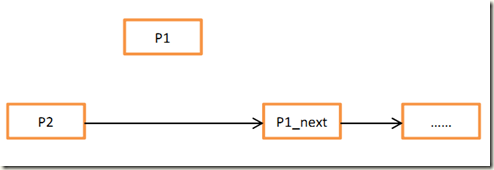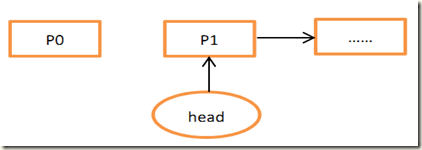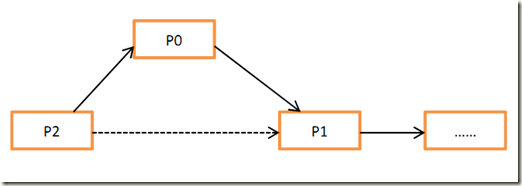[C++面试题]之单链表
接下来我会介绍C++面试题中第二个重要的板块——数据结构,主要包括字符串的使用、堆、栈、排序方法等,今天我们先来看单链表。
1、编程实现一个单链表的建立/测长/打印。
答案:
#include<iostream>usingnamespacestd;//单链表结构体typedefstructstudent{intdata;structstudent *next;}node;//建立单链表node *create(){node *head,*p,*s;intx,cycle=1;head=(node*)malloc(sizeof(node));//建立头节点p=head;while(cycle){printf("\nPlease input the data:");scanf("%d",&x);if(x!=0){s=(node*)malloc(sizeof(node));//每次新建一个节点s->data=x;printf("\n%d",s->data);p->next=s;p=s;}else{cycle=0;}}head=head->next;p->next=NULL;printf("\n yyy %d",head->data);return(head);}//单链表测长intlength(node *head){intn=0;node *p;p=head;while(p!=NULL){p=p->next;n++;}return(n);}//单链表打印voidprint(node *head){node *p;intn;n=length(head);printf("\nNow,These %d records are :\n",n);p=head;if(head!=NULL)p=p->next;while(p!=NULL){printf("\n uuu %d ",p->data);p=p->next;}}
2、编程实现单链表删除节点。
解析:如果删除的是头节点,如下图:
则把head指针指向头节点的下一个节点。同时free p1,如下图所示:
如果删除的是中间节点,如下图所示:
则用p2的next指向p1的next同时,free p1 ,如下图所示:
答案:
//单链表删除节点node *remove(node *head ,intnum){node *p1,*p2;p1=head;while(num!=p1->data && p1->next!=NULL)//查找data为num的节点{p2=p1;p1=p1->next;}if(num==p1->data)//如果存在num节点,则删除{if(p1==head){head=p1->next;free(p1);}else{p2->next=p1->next;}}else{printf("\n%d could not been found",num);}return(head);}
3、编写程序实现单链表的插入。
解析:单链表的插入,如下图所示:
如果插入在头结点以前,则p0的next指向p1,头节点指向p0,如下图所示:
如果插入中间节点,如下图所示:
则先让p2的next指向p0,再让p0指向p1,如下图所示:
如果插入尾节点,如下图所示:
则先让p1的next指向p0,再让p0指向空,如下图所示:
答案:
//单链表插入节点node *insert(node *head,intnum){node *p0,*p1,*p2;p1=head;p0=(node *)malloc(sizeof(node));p0->data=num;while(p0->data > p1->data && p1->next!=NULL){p2==p1;p1=p1->next;}if(p0->data<=p1->data){if(head==p1){p0->next=p1;head=p0;}else{p2->next=p0;p0->next=p1;}}else{p1->next=p0;p0->next=NULL;}return(head);}
4、编程实现单链表的排序。
答案:
//单链表排序node *sort(node *head){node *p,*p2,*p3;intn;inttemp;n=length(head);if(head==NULL ||head->next==NULL)//如果只有一个或者没有节点returnhead;p=head;for(intj=1;j<n;++j){p=head;for(inti=0;i<n-j;++i){if(p->data > p->next->data){temp=p->data;p->data=p->next->data;p->next->data=temp;}p=p->next;}}return(head);}
5、编写实现单链表的逆置。
解析:单链表模型如下图所示:
进行单链表逆置,首先要让p2的next指向p1,如下图所示:
再由p1指向p2,p2指向p3,如下图所示:
让后重复p2的next指向p1,p1指向p2,p2指向p3。
答案:
//单链表逆置node *reverse(node *head){node *p1,*p2,*p3;if(head==NULL || head->next==NULL)returnhead;p1=head;p2=p1->next;while(p2){p3=p2->next;p2->next=p1;p1=p2;p2=p3;}head->next=NULL;head=p1;returnhead;}
6、编程实现删除单链表的头元素。
答案:
//删除单链表的头元素voidRemoveHead(node *head){node *p;p=head;head=head->next;free(p);}
7、给出一个单链表,不知道节点N的值,怎么只遍历一次就可以求出中间节点,写出算法。
解析:设立两个指针,比如*p和*q。p每次移动两个位置,即p=p->next->next,q每次移动一个位置,即q=q->next。当p达到最后一个节点时,q就是中间节点了。
答案:
//给出一个单链表,不知道节点N的值,怎么只遍历一次就可以求出中间节点voidsearchmid(node *head,node *mid){node *p,*q;p=head;q=head;while(p->next->next!=NULL){p=p->next->next;q=q->next;mid=q;}}
8、给定一个单向链表,设计一个时间优化并且空间优化的算法,找出该链表的倒数第m个元素。实现您的算法,注意处理相关的出错情况。m定义为当m=0时,返回链表最后一个元素。
解析:这是一个难题,我们需要的是倒数第m个元素,所以如果我们从某个元素开始,遍历了m个元素之后刚好到达链表末尾,那么这个元素就是要找的元素。也许从链表的尾部倒推回去不是最好的办法,那么我们可以从链表头开始计数。
思路一:我们可以先一次遍历求出链表的总长度n,然后顺序变量求出第n-m个元素,那么这个就是我们要找的元素了。
思路二:我们用两个指针,一个当前位置指针p和一个指向第m个元素的指针q,需要确保两个指针之间相差m个元素,然后以同样的速度移动它们,如果当q到达链表末尾时,那么p指针就是指向倒数第m个元素了。
答案:
//思路一node *searchLastElement1(node *head,intm){if(head==NULL)returnNULL;node *p=head;intcount=0;while(p!=NULL){p=p->next;count++;}if(count<m)returnNULL;p=head;for(inti=0;i<count-m;i++){p=p->next;}returnp;}//思路二node *searchLastElement2(node *head,intm){if(head==NULL)returnNULL;node *p,*q;p=head;for(inti=0;i<m;i++){if(p->next!=NULL){p=p->next;}else{returnNULL;}}q=head;while(p->next!=NULL){p=p->next;q->next;}returnq;}
这一节写完了,宿舍断电了,去睡觉..


















【推荐】国内首个AI IDE,深度理解中文开发场景,立即下载体验Trae
【推荐】编程新体验,更懂你的AI,立即体验豆包MarsCode编程助手
【推荐】抖音旗下AI助手豆包,你的智能百科全书,全免费不限次数
【推荐】轻量又高性能的 SSH 工具 IShell:AI 加持,快人一步
· .NET Core 中如何实现缓存的预热?
· 从 HTTP 原因短语缺失研究 HTTP/2 和 HTTP/3 的设计差异
· AI与.NET技术实操系列:向量存储与相似性搜索在 .NET 中的实现
· 基于Microsoft.Extensions.AI核心库实现RAG应用
· Linux系列:如何用heaptrack跟踪.NET程序的非托管内存泄露
· TypeScript + Deepseek 打造卜卦网站:技术与玄学的结合
· 阿里巴巴 QwQ-32B真的超越了 DeepSeek R-1吗?
· 【译】Visual Studio 中新的强大生产力特性
· 10年+ .NET Coder 心语 ── 封装的思维:从隐藏、稳定开始理解其本质意义
· 【设计模式】告别冗长if-else语句:使用策略模式优化代码结构